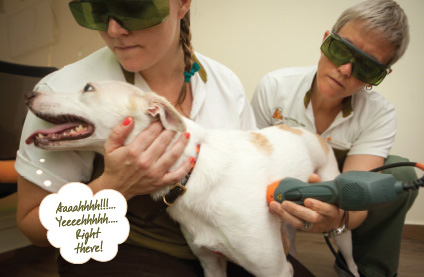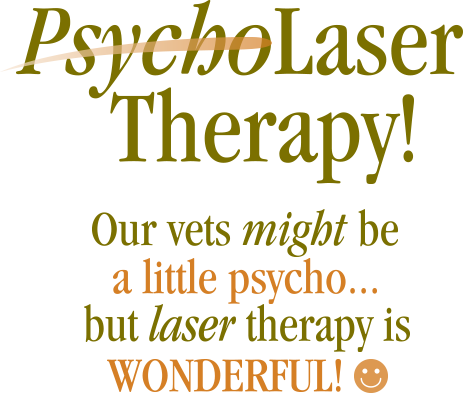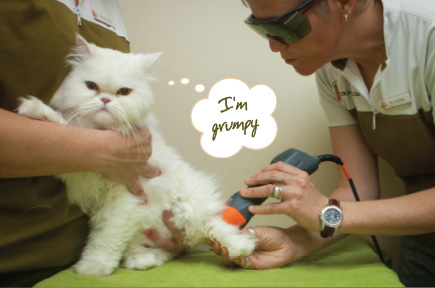laser therapy for pets
SO, WHAT IS LASER THERAPY?
Well, it's a bit of high-tech which promotes and speeds up the body's natural healing processes in dogs, cats, rabbits, horses and many other types of animal by reducing inflammation, muscle spasms, pain and swelling, as well as stimulating cellular function to repair and heal damaged tissue.

The list of conditions that are treatable with laser therapy is pretty long, including acute and chronic pain and inflammation, post-operative pain, skin wounds, ulcers, gingivitis and stomatitis, intervertebral disc disease, muscle contracture, sprains, strains, trigger points, peri-anal fistulas, fractures, oedema, arthrosis/arthritis, eosinophilic granuloma and back pain.

- 15-30 minute sessions
- 2-10 sessions, depending on need
- Treats all pathologies involving pain, inflammation, wounds, swelling and ulcers
- Non-Invasive
- Painless (True!)
- And it will break ONLY ONE of your piggy banks! (Kidding!)

Laser therapy uses light to enhance and speed up the natural healing processes in our pets (and us!) by delivering energy to affected tissue, where it interacts with specific molecules, which leads to several different biological effects. These different effects are important and relate to the various characteristics of the laser beam produced and used. Wavelength, power, temission modality, frequency and amplitude of pulses (for pulse lasers) all account for differences in effect on whatever tissue type the therapy is intended for... and the combination of all these things has made possible the development of specific treatment settings and programmes (in our little machine) for various conditions in different sizes of animals.
The word "LASER" is actually an acronym for Light Amplification by Stimulated Emission of Radiation. Developments in technology and improvements in knowledge about the effect of light on living beings has resulted in laser therapy becoming one of the most popular techniques used today in physical therapy.
Aaaaannnd... it's painless and non-invasive! During the therapy, your pet is wide awake and is free to let us know if he's not happy about something (no biting please!). Most of the time, all types and temperaments of pet just lie there comfortably and quietly... sometimes even sleeping!
HAVE WE SOLD YOU YET? 
The process begins with diagnosing your pet's condition correctly (OBVIOUSLY!) and understanding whether or not she will benefit from this type of therapy. If the decision by our vet and you together is to go ahead with the therapy, it will be important that both our vet and you carefully and closely monitor your pet's reaction/response to the treatment because if there has been no happy response after three sessions, then either the configuration of the treatment itself needs to be adjusted (in our little machine), the frequency of treatments needs to be changed, or the diagnosis itself needs to be questioned and reevaluated.

A session lasts about 15-30 minutes, and a full treatment cycle usually involves 2-10 of these sessions, depending on the nature of the problem. Generally speaking, the more chronic the problem, the longer the treatment cycle is expected to be; so, acute injury will require fewer sessions than, for example, a chronic case of longstanding arthritis. Skin wounds are different, usually requiring daily treatments with the laser until healing has occurred. For all other conditions, treatments either happen every second or third day depending on the case and how your pet responds.
SO... READY YET?
In truth (really, in truth!), laser therapy is a painless, non-invasive, quite wonderful treatment which takes very little time and almost always results in a happier, more comfortable pet... and pet owner. And you can even join your pet and the vet in the sessions!





